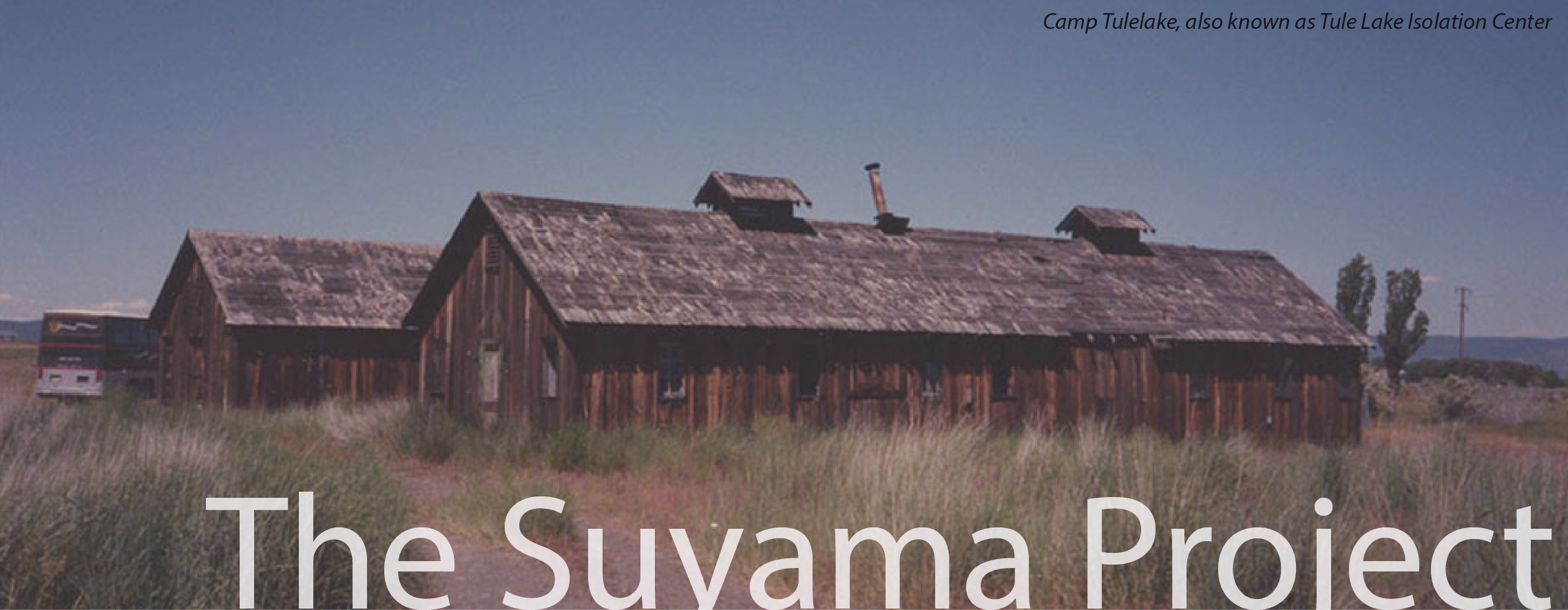
|
UCLA Asian American Studies Center's Suyama Project aims to preserve the history of Japanese American resistance during World War II, including, but not limited to the 100th/442nd Regimental Combat Team draftees, Army and draft resisters, No-Nos, renunciants, and other Nikkei dissidents of World War II. The Suyama Project is made possible through the generous gift of an anonymous donor who wanted to honor and remember the legacy of resistance, broadly understood. |
|
The Learning Center provides introductory information about the different areas of the Suyama Project. Shattering the Myth of the "Quiet American" Shortly after Japan attacked Pearl Harbor, people of Japanese descent living on the West Coast were removed from their homes and imprisoned in United States concentration camps. The stereotype that formed of Japanese Americans from this experience was that of the "quiet" American who went "quietly" into the camps, never questioned the constitutionality of their incarceration, agreed to serve in the military while imprisoned in the camps to prove their loyalty and "quietly" returned to their pre-war lives after the war…[more] Everyday Popular Resistance
There was what can be called "popular" or "everyday" resistance from within the United States concentration camps from almost all the inmates over the injustices they endured as a result of imprisonment.
These actions may have manifested themselves in a number of ordinary ways such as, but not limited to:
These collective and creative acts of resistance appear in all sorts of documents in the archives and are given voice in oral history interviews.
However, the Suyama Project website will focus and highlight the larger protests. During World War II, there was only a handful of Japanese American conscientious objectors (CO). Unlike Japanese American draft resisters who were willing to serve in the armed forces once their rights were restored, COs refused combat service on grounds of freedom of thought, conscience and/or religion.
Japanese Americans filed several legal challenges during World War II in an effort to reclaim their constitutional and human rights. These cases ranged from several draft resisters' lawsuits such as Fujii vs. the United States to a number of renunciation lawsuits such as McGrath vs. Abo. There were hundreds of Japanese American serving in the U.S. Army before Japan attacked Pearl Harbor. However, after Pearl Harbor, Japanese American servicemen were placed into segregated units and had their weapons taken away. The government also denied the request of these men to go assist their families on the West Coast who were being forcibly placed into U.S. style concentration camps. Those who protested their discriminatory treatment by the U.S. Army either ended up in the 1800th Engineer General Battalion or were imprisoned at Leavenworth. Moab/Leupp Citizen Isolation Center The government first set up the Moab Citizen Isolation Center in December 1942 Utah to imprison Japanese Americans from the WRA camps, whom the government deemed as “troublemakers.” In April 1943, Moab was closed and the Leupp Citizen Isolation was opened in Arizona. By the end of the year, the government quietly closed down Leupp after abuses were reported. In order for the U.S. government to separate the so-called “loyal” from the “disloyal” Japanese Americans, the government came up with a so-called loyalty questionnaire. The two most controversial questions were questions 27 and 28. Those who left the two spaces blank or answered yes with a “if-yes” conditional clause or answered “no” to each question were labeled as “no nos” and sent to Tule Lake, which was converted from a War Relocation Authority camp into a Segregation Center. By 1944, anti-Japanese politicians and organizations were searching for ways to legally deport Americans of Japanese descent from the camps. What resulted was the passage of Public Law 405, which allowed U.S. citizens to renounce their citizenship in times of war, upon the approval of the attorney general. From the spring until the fall of 1942, the Japanese American community was in constant flux as the Army sent some groups directly to camps, while with others, the Army temporarily imprisoned them at assembly centers and then shipped them off to camps. The Statements of Resistance are actual examples of the petitions and demands as written by Japanese Americans in their own words while imprisoned in the concentration camps. Timeline of Resistance 1942-46 The Timeline of Resistance 1942-1946 was compiled by Yuri Miyagawa, with assistance from Chizu Omori. Tule Lake Citizen Isolation Center During World War II, the United States government had established three, not two citizen isolation centers as previously thought, according to groundbreaking research done by Roger Daniels, emeritus history professor and pioneer scholar in Japanese American history and Barbara Takei, an independent writer/researcher and Tule Lake Committee chief financial officer. Tule Lake War Relocation Authority Camp Block 42 In February 1943, the U.S. military police illegally rounded up close to 35 men living in Block 42 of the Tule Lake War Relocation Authority camp for refusing to register for the so-called loyalty questionnaire. RESOURCESOur Resources section contains print, media, and online citation sources. Please click here to browse through the Resources. |